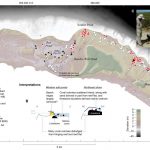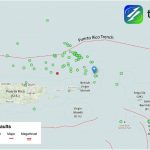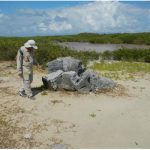Evidence for pre-Columbian tsunamis in the Caribbean?
 By David Jacobson, From Temblor
By David Jacobson, From Temblor
In a journal article published earlier this week, researchers at the University of Washington, USGS, and several other institutions outlined evidence of extreme waves in the British Virgin Islands. The evidence for this coastal inundation are brain corals scattered up to one third of a mile inland from the northern coastline of the island of Anegada.
In order to get over 200 brain corals, which in some instances are several meters in diameter, so far inland, inundation would not only have to be extreme, but violent enough to detach living corals from a Caribbean reef. The scientists have two theories, a rare tsunami or an unusual hurricane. The tsunami source would likely be the distant Puerto Rico Trench, which lies 120 km north of the island. While this trench sits on the boundary between the North American and Caribbean plates, where large earthquakes are possible, no documented tsunamis have even been generated here. Having said that, there are other potential sites along the plate boundary where active faulting could generate a destructive tsunami.
So, does the fact that no tsunami has ever been recorded discount the possibility that one occurred in pre-Columbus (1492) times? Not necessarily. While it can be extremely difficult to prove that clasts were displaced by tsunamis, the argument often hinges on the idea that storm waves are not capable of transporting exceptionally large clasts so far inland. And, in the case of Anegada, no modeled hurricane storm surge or historical hurricane has resulted in inundation that matches the extent of the displaced brain coral. The reason behind this is the deep water just off the northern coast, and a fringing reef, both of which help dissipate energy. It is important to note however, that these characteristics do not have the same effect on tsunamis, which are in fact aided by deep water because less energy is extracted. While this would appear to suggest that a tsunami is the only possible explanation for the displaced coral, in 2013, Typhoon Haiyan in the Philippines generated tsunami-like surges, in what can be described as an unusual event. This is why the Brian Atwater and his team believe the culprit is either a tsunami or an unusual hurricane. It should be noted that the effect of tsunami-like surges similar to those seen in the Philippines have not been modeled for Anegada.
Despite this lack of modelling, the scientists believe that the “burden of proof” rests more with an unusual storm than with a locally-sourced tsunami. This is likely due to the lack of evidence of past tsunamis and the regularly-occurring hurricanes which hit the Caribbean. Regardless of the exact cause, the findings by Brian Atwater and his team help bring scientists a little bit closer to determining if large local-sourced tsunamis are possible in the Caribbean. Additionally, people in the British Virgin Islands believe that the more evidence they have of large destructive waves, the better their public outreach efforts will do.
References
Brian F. Atwater, Uri S. ten Brink, Anna Lisa Cescon, Nathalie Feuillet, Zamara Fuentes, Robert B. Halley, Carlos Nuñez, Eduard G. Reinhardt, Jean H. Roger, Yuki Sawai, Michaela Spiske, Martitia P. Tuttle, Yong Wei and Jennifer Weil-Accardo, Extreme waves in the British Virgin Islands during the last centuries before 1500 CE, Geosphere(2017), DOI: 10.1130/GES01356.1
USGS Press Release “Enormous Caribbean Waves Before 1492”
IMAGES:
anegada-brian-coral-map
This map, from Atwater et. al., 2017 shows the locations (red dots) of the displaced brain corals around the northern coast of Anegada. (Figure from: Atwater et. al., 2017)
caribbean-fault-map
This Temblor map shows the location of Anegada relative to the nearby Puerto Rico Trench. While no tsunamis have been recorded to have occurred here, scientists believe it is possible.
caribbean-tsunami-anegada-brain-coral
This picture shows Brian Atwater next to one of the displaced brain corals. This particular coral is 8 feet in diameter. (Photo from: Brian F. Atwater, U.S. Geological Survey. Public domain)
anegada-british-virgin-islands-tsunamis
A recent study has shown evidence of large, destructive waves in the British Virgin Islands on Anegada. (Photo from: enjoyourholiday.com)
For more on this story go to: http://temblor.net/earthquake-insights/evidence-for-pre-columbian-tsunamis-in-the-caribbean-2839/








